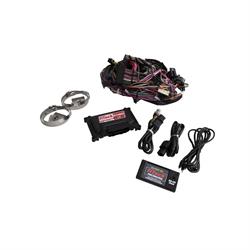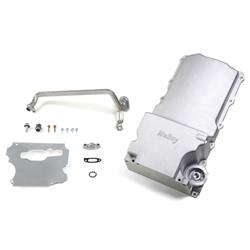LS Swaps
By now, you've probably seen the video announcing that our Project Chevelle got LS swapped. Maybe you've even read the tech article detailing what it took to make it happen. And I'll bet you have an opinion about it.
LS swaps remain a polarizing topic, even though they've been happening for over 20 years now. The LS1 first appeared in the '97 Corvette, and almost immediately the aftermarket began to prepare for the inevitable few who wanted to jump on this newest marvel of Detroit engineering. This is a time-honored tradition; hot rodders have always grabbed the newest technology available and used it in the attempt to make their cars go faster. Sometimes this works out, and industry-changing powerplants are born (flathead V8, small and big block Chevy, Hemi, 5.0 Ford, etc.) and sometimes it fizzles out almost immediately (remember the Cadillac Northstar?). Well, the LS is no Northstar. It's the flathead Ford and small block Chevy of the modern age.
But there are still folks who hate them. And I get that. I'm a bit of a traditionalist when it comes to old cars, and while the LS is a lot of things, it's not traditional. There's also the fear of the unknown. Those of us who grew up changing Holley jets and hooking up that one wire to an HEI distributor see a lot of things on an LS that don't make sense. And we're scared.
And they are everywhere. Go to any car show or Friday night cruise and it seems like just about everyone has an LS-based engine under the hood. It's almost a surprise when you encounter a good old small block Chevy. It's reminiscent of the early 50's, when the Olds, Cadillac, and Chrysler overheads began to own all the magazine ink as well as all the records at Bonneville and the drags. The writing was on the wall for the flathead faithful, but some of them held out. The flathead was familiar to them, and with more modern options available, it was also a little rebellious. Thumbing our noses at convention and trendiness has always been a central part of gearhead DNA.
So with all of that being said, why did we jump on the bandwagon and LS swap our beloved Project Chevelle? Well, it's our job at Speedway Motors to have the parts that you need to build whatever you are dreaming about. And there are a lot of folks dreaming about LS swaps. It's also our job to know what we're selling, and what better way to do that than to actually use our parts on our own projects. That's what the Toolbox is all about, and that's what Project Chevelle is here for. It's a platform for us to install and use our parts so that we know how to answer your questions when you call. Have a question about putting a 383 in your muscle car? We can help you, because we just did it. Have a question about doing an LS swap? We can help you there too.
Personally, I loved the car with the 383. I loved that when the hood came up, it looked just like 1972 right down to the white headers and dual-snorkel air cleaner. To me this was just about perfect. But the most traditional thing in hot rodding is constant change, and clinging to what's old and familiar is a quick way to get passed by, both on the track and in the industry. You may have noticed some changes to our company's look lately, too. The old Speedway logo is gone, but it will live forever in our photo albums and on the fenders of our old racecars. In the same way, the old Chevy small block (and yes, even the Flathead Ford) will live on in many of our cars. But our company has a new look and a new logo, and you'll soon see it all over the place, just like you're going to keep seeing LS swaps wherever you go.
And what happens when the next big thing comes along? You can bet we'll be here to help you with that, too.
But don't worry, we'll still sell small block Chevy parts.
Where do you stand on the whole LS swapping trend? Share your thoughts on our Facebook page HERE!





